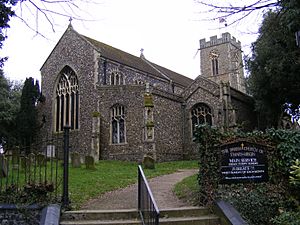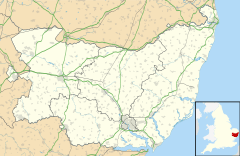Halesworth facts for kids
Quick facts for kids Halesworth |
|
|---|---|
 Church of St Mary, Halesworth |
|
| Area | 4.47 km2 (1.73 sq mi) |
| Population | 4,726 (2011 Census) |
| • Density | 1,057/km2 (2,740/sq mi) |
| OS grid reference | TM388773 |
| District |
|
| Shire county | |
| Region | |
| Country | England |
| Sovereign state | United Kingdom |
| Post town | HALESWORTH |
| Postcode district | IP19 |
| Dialling code | 01986 |
| Police | Suffolk |
| Fire | Suffolk |
| Ambulance | East of England |
| EU Parliament | East of England |
| UK Parliament |
|
Halesworth is a lively market town in north-eastern Suffolk, England. About 4,700 people lived here in 2011. It's located about 15 kilometres (9 miles) south-west of Lowestoft. The town sits on a small river that flows into the River Blyth.
Halesworth has its own Halesworth railway station. This station is on the East Suffolk Line, which connects Ipswich and Lowestoft. The town is also twinned with two towns: Bouchain in France and Eitorf in Germany. This means they have a special friendship and often exchange visits.
Contents
Discover Halesworth's Past
Halesworth has a long and interesting history.
Early History and Famous People
Did you know that a bank in Halesworth once printed its own money? A special banknote from 1799 was found recently. The Angel Hotel, built in the early 1500s, was a very important place. It was a coaching inn where people could stay and meet.
A famous botanist (someone who studies plants) named Sir Joseph Dalton Hooker was born in Halesworth in 1817. He was a great traveller and explorer. A building called Hooker House, now a dental office, is named after him. He was a close friend of Charles Darwin, who developed the theory of evolution.
The Rifle Hall and Old Theatre
The Rifle Hall is a building with a cool story. It was given to the town in 1862. It got its name because it was used by a local rifle group for training. But before that, it was a theatre! From 1812 to 1844, a theatre manager named David Fisher used it. He had a travelling theatre group that performed all over East Anglia. They would travel with their costumes and sets, putting on plays for two years before completing their circuit.
Quay Street and the River
Quay Street gets its name from the old town quay. In the mid-1700s, the river was made deeper so boats could travel from Halesworth to Southwold. This made it much easier to bring goods like coal into the town. You can still see parts of the old river path in the Town Park today. The Town Park itself was created by Donald Newby and Lady Rugby, who donated some land.
Notable Residents
From 1822 to 1831, a man named Richard Whatley was the Rector (a type of church leader) of Halesworth. He was a well-known academic who spoke out against slavery. He later became the Archbishop of Dublin. A famous actor, Kevin Whately, is one of his descendants.
How Halesworth is Governed
Halesworth is looked after by different councils. Since 2019, it's been part of the East Suffolk district council and the Suffolk County Council. These councils help manage local services like roads, schools, and parks.
Halesworth also has its own Town Council, which started in 1974. There are 12 Town Councillors who are chosen every four years. They elect a chairman and vice-chairman from among themselves.
Exploring The Thoroughfare
The Thoroughfare is a historic street in Halesworth. In 1991, during some digging near the White Hart pub, parts of an old pathway were found. This pathway likely dates back to the late Saxon period (around 1,000 years ago!). A piece of oak from this discovery is now in the Halesworth & District Museum.
You can see buildings from the 1500s, 1600s, 1700s, and 1800s along The Thoroughfare. Number 8 used to be an ironmonger's shop (selling metal tools and goods). This shop belonged to the grandfather of the famous TV presenter Sir David Frost. You can still see the name "William Frost" under an archway next to the shop.
A group of four shops nearby was originally built in 1474 as the Guildhall. This was a meeting place for important groups called the Guild of St John the Baptist and the Guild of St Love and St Anthony.
Arts, Nature, and Wildlife
Halesworth is home to the New Cut Arts Centre. This is a place where you can enjoy different kinds of art and performances.
The town also has the largest Millennium Green in the UK. This is a huge area of about 44 acres (18 hectares) of grazing marsh. It's a wonderful place for wildlife, right near the town centre! The rivers in this area are home to amazing creatures like grey herons, colourful common kingfishers, and playful Eurasian otters.
Halesworth's Railways
Halesworth railway station connects the town to Ipswich and Lowestoft. Trains are run by Abellio Greater Anglia.
- 1854: The railway first arrived in Halesworth.
- 1859: The station moved to its current spot when the line was extended to Lowestoft.
- 1888: A special movable platform was added. It was updated in 1922 and fixed up again in 1999. This platform allows trains to extend across the nearby level crossing.
- 1958: The Norwich Road railway bridge opened, providing another way to cross the tracks instead of the level crossing.
From 1879 to 1929, a special narrow-gauge line called the Southwold Railway connected Halesworth to Southwold. This type of railway has tracks that are closer together than usual. There were plans to bring parts of this railway back, but now there's a new idea for a railway park in Southwold instead.
St Mary's Church
Halesworth is even mentioned in the Domesday Book from 1086! This old book recorded that a priest named Ulf was in charge of the church parish back then.
The main part of the current church was built in the early 1400s. More parts were added and fixed up in the late 1800s. During these repairs, some clues were found that an even older church with a round tower might have been on the same spot.
Inside the church, you can see special carved stones called Danestones. They show hands holding plants or tails. No one knows exactly when they were made or where they were originally placed. However, some experts think they might be part of an Anglo-Saxon carving from the late 800s.
Today, St Mary's Church is the main church for the Blyth Valley Team Ministry, which includes eleven different parishes (church areas). You can also see a beautiful statue of the Madonna and Child in the Lady Chapel. It was made from driftwood by an artist named Peter Eugene Ball.
Local Media and News
If you want to know what's happening in Halesworth, you can find local news and TV shows from BBC East and ITV Anglia. You can also listen to local radio stations like BBC Radio Suffolk (95.5 FM), Heart East (102.4 FM), Greatest Hits Radio East (97.4 FM), and Kiss (106.1 FM). The town also has local newspapers like the Beccles and Bungay Journal and the Eastern Daily Press.
Sports and Activities
Halesworth offers several sports for you to enjoy!
- Golf: There's a 27-hole golf club where you can practice your swing.
- Football: Halesworth Town F.C. and Wenhaston United F.C. are the local football teams.
- Tennis: Halesworth has a tennis club with courts.
- Bowls: There's also a bowls club, both located in the Dairy Hill area.
See also
 In Spanish: Halesworth para niños
In Spanish: Halesworth para niños



